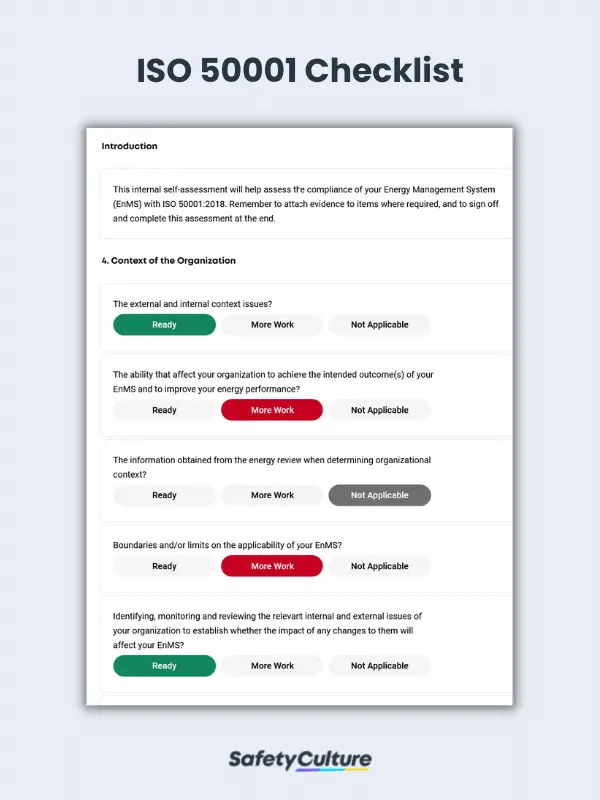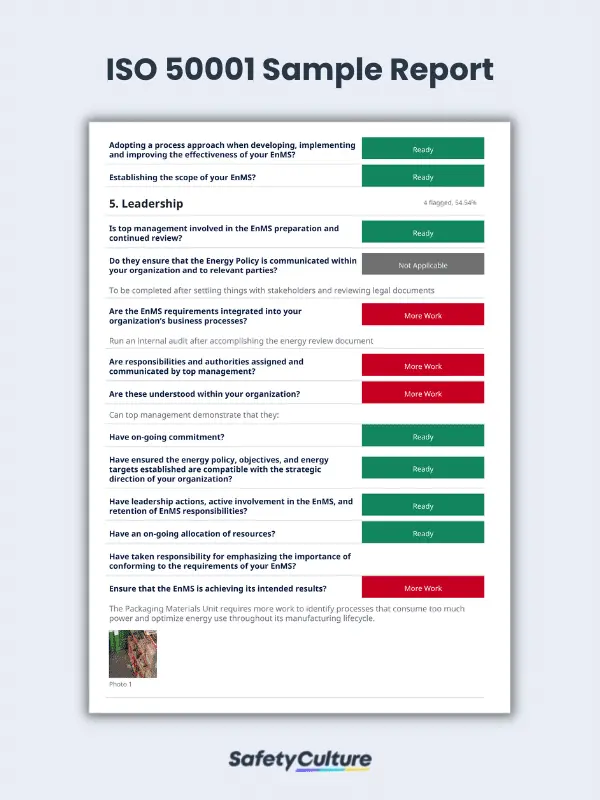What is an ISO 50001 Checklist?
An ISO 50001 checklist is a document that guides organizations seeking to establish an ISO-compliant Energy Management System (EMS). With an ISO 50001 checklist, they can efficiently improve energy performance through rigorous internal audits, corrective actions, and consistent energy monitoring. Organizations can use this checklist to see how their business activities measure against ISO’s EMS benchmarks before proceeding with the certification program.
Benefits
ISO 5000:2018 is an international standard that provides a framework that encourages an organization’s leadership to promote the efficient use of energy in the organization through an effective EMS. This standard seeks to improve energy performance in organizations through significant changes in management practices and processes with regard to energy consumption. To implement it successfully, businesses must incorporate the standard into all aspects of their operations.
However, this task is easier said than done, given how complex the standard can get and how urgent the need to be more energy efficient is based on current situations. For the given reasons, an ISO 50001 checklist proves to be a valuable tool for organizations. It offers them an organized flow of activities that they must accomplish to satisfy ISO requirements, as well as conduct internal audits effectively.
Moreover, an ISO 50001 checklist can help your organization:
- Establish a systematic approach to internal assessment processes
- Verify if a business area or activity conforms to ISO’s EMS framework
- Reduce lapses and missed items during self-audits
- Ensure consistent and complete implementation of ISO 50001 standards across all teams and departments
- Comply with the Energy Savings Opportunity Scheme (ESOS)
What to Include in an ISO 50001 Checklist
There are many ways to create an ISO 50001 checklist depending on your needs and industry. However, a typical ISO 50001 checklist should include the following sections:
- Context of the organization
- Leadership
- Planning
- Support
- Operation
- Performance evaluation
- Improvement
- Sign off
6 Steps on Using the ISO 50001 Checklist
Now that you know the advantages of using a checklist for your EMS, it’s time to learn how this tool works. Here’s a simple guide on completing an ISO 50001 audit checklist:
1. Secure management commitment and support.
The ISO 50001 checklist begins with a declaration of commitment from the organization’s top management, as per the standard’s Leadership Clause. After all, their role is crucial in successfully carrying out an ISO-compliant EMS.
The key areas that require management support are as follows:
- Continuous improvement initiatives in energy performance
- Sufficient resources to achieve EMS goals and targets (people, financial, material, etc.)
- Legal compliance concerning energy consumption and use
2. Set the organization’s energy policy.
The upper management’s commitment to a world-class EMS culminates in the form of a written energy policy. This section highlights the responsibilities of the organization’s leadership team to achieving energy-efficient operations and serves as a basis for setting goals, objectives, action plans, and continuous improvement efforts.
3. Establish an EnMS plan.
Upon creating a sound energy policy, it’s time to lay out the organization’s EMS plan. This plan should root itself in the provisions stated in the sixth clause (Planning) of the most recent ISO 50001 standard.
An effective EMS plan consists of the following elements:
- Legal and other requirements relevant to energy efficiency, use, and consumption
- Energy review
- Energy baseline
- Energy Performance Indicators (EnPIs)
- Energy objectives and targets
- Energy management action plans
4. Note observations about the EMS implementation.
Once the groundwork is complete, it’s time to carry out the EMS plan. At this point, it’s a must to keep a close eye on and record every part of the organization’s EMS, especially in areas with significant energy use, to see how the plan works in practice.
This section covers two clauses of the ISO 50001:2018 standard: Clause 7 (Support) and Clause 8 (Operation). When writing down your observations, it’s important to consider the following factors:
- Employee training and competency – ensuring employees understand the general concept of energy efficiency and are capable of carrying out energy management tasks
- Operational controls – examining business activities, processes, and practices that significantly contribute to the organization’s energy consumption and identifying control procedures to regulate them
- Design – determining opportunities for energy performance improvement in existing and prospective facilities, equipment, and systems
- Stakeholder communication – informing staff members and external stakeholders about the organization’s EMS, energy policy, and energy performance
- Supply chain – extending energy efficiency standards and initiatives to suppliers during the procurement process
5. Measure the effectiveness of the established EMS.
A functional EMS requires not only proper implementation but also robust monitoring and evaluation mechanisms. These tools allow organizations to gauge the impact of their EMS and how they measure against the established energy goals and performance indicators.
For this reason, it’s a must for organizations to carry out the following processes for checking their EMS and energy performance:
- Keeping track of energy outputs, EnPIs, and SEUs
- Monitoring the progress of action plans in achieving the organization’s energy efficiency goals and targets
- Verifying compliance with legal and similar requirements for sustainable energy use
- Conducting regular internal audits to determine how the organization’s EMS matches up against ISO standards
- Identifying nonconformities and lapses in the EMS implementation
- Carrying out appropriate corrective and preventive actions to resolve energy issues
- Maintaining EMS records as proof of conformity and compliance with the ISO standard
6. Review the EMS for continuous improvement.
An ISO 50001 checklist wraps up with the final clause of the standard: a management review of the established EMS. In this section, the organization’s leaders can identify opportunities for continuous improvement and evaluate if the current EMS is effective, adequate, and appropriate for the organization.
Moreover, it allows them to determine external and internal issues that affect energy performance through internal audits, monitoring systems, and other indicators. This way, they can modify the EMS to address these deficiencies and find strategies that work for the organization.
Example
Here is a sample ISO 50001 checklist in use for reference:
FAQs about ISO 50001 Checklists
ISO themselves do not provide certifications, but rather, there are dedicated external auditing and certifying bodies around the world that can certify you for compliance with ISO 50001: 2018.
ISO 14001 and ISO 50001 often work together in promoting a more environmentally-friendly workplace, but deal with different things. ISO 14001 deals with how to use resources and how to conduct an efficient waste and pollution management system. On the other hand, ISO 50001 deals with how to generally optimize energy use while reducing greenhouse gas emissions.
An ISO 50001 checklist should include the following sections:
- Context of the organization
- Leadership
- Planning
- Support
- Operation
- Performance evaluation
- Improvement
- Sign off
Internal audits are typically performed by auditors who are qualified for auditing management systems such as ISO 50001. The ISO 19011 standard guides organizations in selecting competent auditors for their EMS assessment.
For best results, an ISO 50001 internal audit should take place at least once a year within the three-year audit cycle. This audit should cover all business areas relevant to the EMS and define its purpose, scope, parameters, and persons involved.




